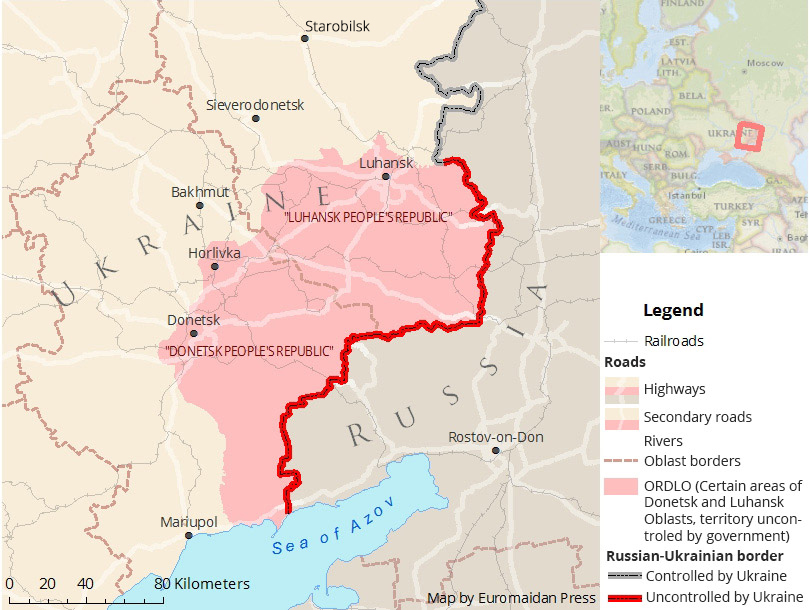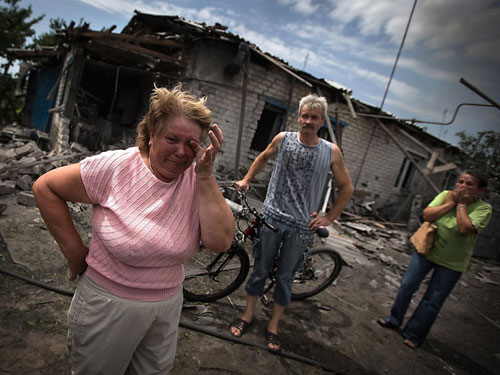The coup was triggered by a ruling of the so-called Luhansk city Leninskyi district court dismissing an “LNR” internal minister Igor Kornet. On 20 November, Russian-installed head of “LNR” Igor Plotnitsky signed a decree on the resignation of the “minister.”
In the early morning of the next day, 21 November, masked gunmen without insignia dressed up to look like Putin’s “little green men” in Crimea amid its annexation blocked several central streets, cordoned off government buildings and the TV station in downtown Luhansk.
#Luhansk @Bylbyleva171117 pic.twitter.com/sSYYtnlpX8
— English Luhansk (@loogunda) November 21, 2017
[~10:00] #Luhansk:
screenshot #1 #Polskoho St (=MVD),
#2-3 #Demyokhina St (another st in the center) @rjpthjultnb https://t.co/ClQcl3aDl2 pic.twitter.com/4ARKElzWgB— English Luhansk (@loogunda) November 21, 2017
Відео з Луганська.
Слідкуємо за подіями у "живому блозі": https://t.co/nChCOSG7Gp pic.twitter.com/p4LdRPL8OO
— Радіо Свобода (@radiosvoboda) November 21, 2017
Footage by Radio Liberty Ukraine from Luhansk
In a video address, Igor Kornet called his resignation “a rumor.” In order to explain the presence of the armed men and military equipment in the center of the city he told that a “large Ukrainian subversive group” was detained by the police and those men without insignia wearing white armbands are the police forces who are trying to catch the rest of the group.
A statement of Igor Plotnitsky was published on the official website of the “head of the republic,” in which he refuted accounts by Kornet, repeating that Kornet was “lawfully removed from his post” and a new acting internal minister has been appointed.
Local TV and radio stations went off-air, only Ukrainian radio signal reached the city. The broadcasting was restored later at night.
In the evening of 21 November, Ukraine’s President Petro Poroshenko held an extraordinary meeting of the Military Cabinet of the National Security and Defense Council of Ukraine in Kyiv. The senior military officials apprised on the illegal crossing of the Ukrainian border in occupied Krasnodon Raion of Luhansk Oblast by Russian tanks.
There also was only one unconfirmed report by a local resident from Khrustalnyi (formerly Krasnyi Luch) about the tanks moving likely towards Luhansk, however, there were no confirms that they reached the oblast’s capital city.

Convoy enters Luhansk from the Donetsk highway
On 21 November, a resident of Donetsk spotted 7 military trucks, 2 crowded buses, and 3 BTRs moving out of the city at about 13:00. Later at 16:26 a message on the convoy passing by came from Perevalsk, a city halfway between Debaltseve and Luhansk. Finally, at 16:52 a report on the hardware heading Luhansk came from Vesela Tarasivka, a village near the Luhansk-Donetsk highway 4 kilometers away from the city limits.
The OSCE Special Monitoring Mission (SMM) confirmed the military presence in the center of Luhansk city and reported a convoy of at least six military trucks moving with 2 armored vehicles and over 20 cars towards Luhansk near Debaltseve. Later an SMM patrol spotted “likely the same” convoy near Vesela Tarasivka:
https://www.facebook.com/oscesmm/posts/917408235077549
BTR armored vehicles photographed by the OSCE in Luhansk could be spotted in the early morning of the same day driving out of Makiivka.
About 18:30 a local group on the Russian social network vk.com published a video of the massive military convoy moving through Luhansk from the direction of occupied Donetsk along arterial Radianska Street in the area of the First Micro-district. The convoy included many more vehicles than a Donetsk resident observed going out of the city and later the SMM spotted moving near Debaltseve :
The overpass near the Parkhomenka market is a well-known place among Luhansk residents, however, digital researcher Aric Toler has additionally geolocated the video:
My first try at geolocating of the new video showing the arrival of a massive military convoy in Luhansk from Donetsk. Shot from one of the apartment blocks. pic.twitter.com/VpM3lWoZl2
— Aric Toler (@AricToler) November 21, 2017
According to the further information from Luhansk, the convoy moved further down Radianska Street, then it split at the intersection of Radianska with Oboronna and 16th Line. Some of the vehicles went down towards Druzhba hotel complex, other moved further towards the city’s Eastern Blocks.
Plotnitsky fled. Not
A spokesman for Ukraine’s Ministry of Internal Affairs stated on his Facebook that Igor Plotnitsky fled to Russia. Several pro-Russian sources in Luhansk and Donetsk alleged the same. Meanwhile, this morning a few videos of official meetings of Plotnitsky were published to prove that he is still in Luhansk.
Current situation
As of 16:00 EET 22 November, the coup remains in limbo. The administrative buildings are still cordoned off by the armed men. Kornet still wants Plotnitsky to recognize him a valid minister, Plotnitsky accuses him of the coup attempt.
https://twitter.com/JulianRoepcke/status/933327370240610304
Loyal Kornet
Igor Kornet (call sign TT) was appointed the “LNR internal minister” on 27 August 2014. No signs of a cindering conflict were shown since then between two Igors, Plotnistky and Kornet.
Moreover, he was loyal to Plotnitsky at least in 2014-2015. Kornet and his police “ministry” were behind the first high-profile assassination of a field commander, Aleksandr Bednov (call sign “Batman”) on 1 January 2015. Bednov advocated further military actions against Ukraine despite the Russian will to freeze the conflict back in 2014. Months before his assassination Bednov was barred from the participation in the fake elections staged by Russia on 9 November.
A few more assassinations of the warlords took place later, but the “LNR” authorities took responsibility only for Bednov’s killing as the “prosecutor general’s office” stated that Bednov and his guards struggled on their arrest after the LNR police opened a case against Bednov gang members, charging them with torture of at least 13 civilians. Ukrainian subversive groups were “officially” blamed on further assassinations, but members of armed groups who were in opposition to Igor Plotnitsky blamed the “LNR head.”
Read more: Mysterious deaths of chieftains in Russian-backed “republics” since 2015 in a nutshell
Following the Plotnitsky assassination attempt in August 2016 when an explosive device had been planted on a lamp post and the explosion damaged a car injuring passengers including Plotnitsky, former “LNR prime minister” Gennady Tsypkalov (call sign Ryzhyi) and former deputy head of the Luhansk People’s Militia (army) Vitaly Kiselyov (call sign Communist) were detained by LNR special services for plotting the coup. Tsypkalov was later found hanged in prison cell, Kiselyov was incarcerated.
Read also: Alleged “military coup” followed by purge of “LNR” chieftains
Plotnitsky vs Kornet
In his latest video address where he refuted his dismissal, Igor Kornet said that the “prosecutor general’s office” framed up the case of Tsypkalov and Kiselyov. This may mean that the crackdown on plotters could be the starting point of the conflict between Kornet and Plotnitsky.
The conflict was simmering at least a year, finally earlier this month, on 9 November 2017, Plotnitsky personally dispossessed Kornet of a mansion, which the “chief policeman” seized in 2014 for himself from a family that fled Luhansk as war had erupted.
What’s behind the coup?
The personal conflict within the occupation authorities cannot be a sufficient explanation for the ongoing developments.
Occupied Donetsk invades occupied Luhansk
Pro-Russian journalist Sergey Belous said that “DNR” internal troops were present among the armed groups who occupied downtown Luhansk in the morning of 21 November:
#Luhansk: [pro-RU source] Telling – among armed men in #Luhansk center, there are members of "internal troops" of "DNR", this means the event is aligned to Moscow… https://t.co/OTgWJDXLJf
— English Luhansk (@loogunda) November 21, 2017
One of the BTR infantry fighting vehicles was photographed in Luhansk while blocking Kotelnikova street adjacent to the premises of the former regional police headquarters. The vehicle #771 was marked as “Chechen,” this is a call sign of Donetsk field commander Andrey Borisov and the name of his armed group loyal to “DNR head” Zakharchenko. The same vehicle was earlier spotted with DNR’s special forces unit:
Master open source researcher @5urpher finds the same BTR (#771) that was photographed in Luhansk today. Previously photographed with DNR's Spetsnaz.https://t.co/4NmTx4BxVx pic.twitter.com/SqSNFHM3B2
— Aric Toler (@AricToler) November 21, 2017
At least part of the massive column that entered Luhansk on 21 November was earlier spotted leaving Donetsk.
Despite the obvious facts, DNR military spokesman Eduard Basurin refuted the involvement of the DNR forces in the ongoing events in Luhansk. “All about Luhansk, I don’t know what’s happening there, it’s the other territory,” was his comment to RBC, a Russian news outlet.
A year ago, Donetsk units were also involved in the crackdown on the coup plotters. “DNR” forces protected Plotnitsky then, but this time they are either on the side of Kornet or have been deployed to settle the conflict or at least just stabilize the situation.
Igor Plotnitsky was legitimized as a leader of Luhansk via fake elections which were staged by Russia in fall 2014. Removing Plotnitsky may mean eliminating the LNR project and full transition of the structures formed in Luhansk Oblast under “DNR” command. This is the most unlikely scenario.
Surkov vs. FSB
Puppet-master of Luhansk and Donetsk “people’s republics”, Kremlin’s aide Vladislav Surkov controls the political leadership of the LNR and DNR, while the FSB, a Russian successor of the Soviet KGB secret service, controls law enforcement in the occupied territories. The third Russian party is the Russian Armed Forces, fully controlling the armies formed in Donetsk and Luhansk.
Read also: Russian “siloviki” oversee power vertical of occupied Donbas
As far as the conflict erupted between Surkov-installed head of the LNR Plotnitsky and FSB-controlled Kornet, the coup may be an attempt of the FSB to bolster its influence over the territory.
Fake peacekeepers or reinforcement for winter operations
The convoy spotted in Luhansk last evening moving from the Donetsk direction was one of the biggest manpower deployments witnessed by Luhansk residents since 2015. Given also the tanks deployed in the Krasnodon Raion, the coup may be just a staged conflict to cover the deployment of the Russian military that may be later used as Putin’s peacekeeping forces. So may they be also later engaged in Russian winter military operations. Russia has no significant military victories in the Donbas since 2015 and another short victorious war could be planned for the next winter.
Undermining prisoner exchange and Minsk deals
After the Minsk II agreement was signed in February 2015 by the representatives of the OSCE, Russia, and Ukraine in the Trilateral contact group on settlement of the conflict. Leaders of Russian-run Donbas republic, Plotnitsky and Zakharchenko, set their hands later too. Thus, the coup may undermine the Minsk peace process if new leaders would declare the decisions of Plotnitsky invalid. As well as the prisoner exchange process between Ukraine and LNR/DNR, which was frozen by Russia during the last 14 months, can be endangered again.
Even though the coup still can be used to deploy additional forces in the region as well as to undermine the Minsk process and prisoner exchange.
Read also:
- Russian “siloviki” oversee power vertical of occupied Donbas
- Russian proxy “republic” sentences two pro-Ukrainian football fans to 13 & 17 years
- Mysterious deaths of chieftains in Russian-backed “republics” since 2015 in a nutshell
- Alleged “military coup” followed by purge of “LNR” chieftains
- Ukrainian civil resistance to Russian occupation in Donbas
- Donetsk separatists call to replace Ukraine with Russian imperial province Malorossiya
- First head of Russian-backed “Luhansk People’s republic” Bolotov reported dead
- Executed in Donbas: activists present data on 95 extrajudicial killings
- What assets did Russia’s puppet republics seize from Ukraine? Full list
- Policy shift shows Russia preparing to recognize its puppet republics in Donbas








